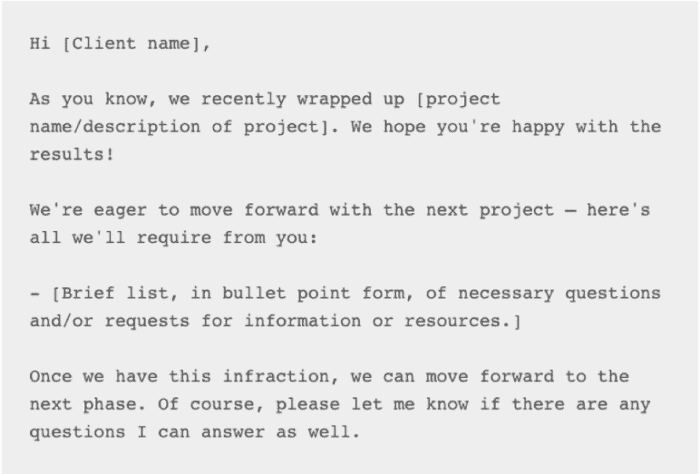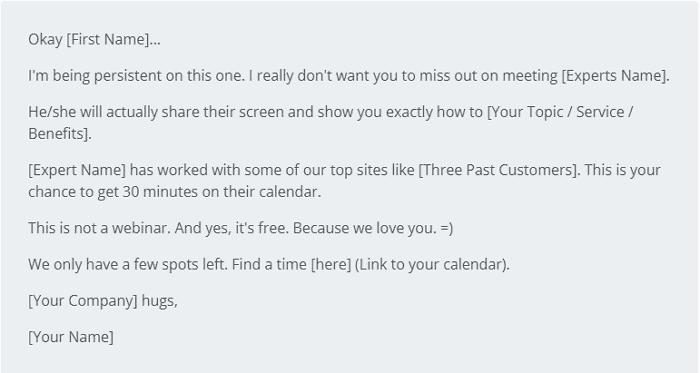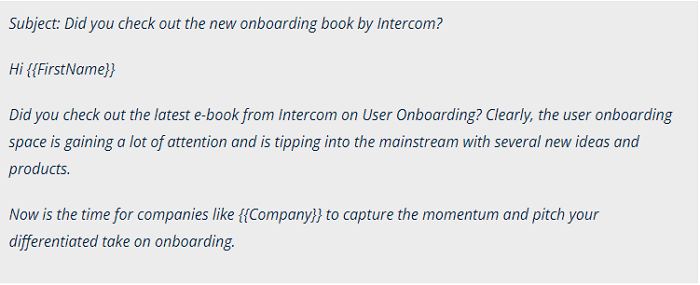
You may have invested hours researching a potential client, then spent a few more coming up with the perfect introductory email. Maybe you want to follow up on a meeting with someone or after sending an invoice.
Whatever your reason, the truth is that coming up with a polite follow-up email that doesn’t make you look pushy or desperate is challenging. That is why you have come to the right place.
In this guide, I will walk through how to write an effective follow-up email that boosts your response rate, helps you land those deals, and puts your targets back on track.

It does not matter if you have been writing follow-up emails that get you zero responses or if you are jumping into the fray for the first time. There are mistakes to avoid and best practices to follow.
Here are the definitive things to consider when crafting that email.
Most people open and reply to an email on the day they receive it. If they were going to reply, you would have gotten an answer.
That means when you eventually send a follow-up email, they have most likely forgotten about the original mail.
Try to jog the recipient’s memory by referencing the initial email or interaction to improve your chances of a response.
Even if they still can’t place you, establishing a previous interaction proves you’re not a stranger and makes it more likely for you to get a positive response.
A lot, if not most, people naturally use “Follow Up” in the subject line when they are crafting a polite follow-up email. I have done that myself a couple of times.
There are a few reasons why it is a wrong move. One, it does not provide any value. Two, it makes the reader feel you’re blaming them for the non-answer. It’s not a motivator.
According to Invesp, 47% of email recipients open an email based on the subject line. Another 22% are more likely to open when it is personalized.
Instead of ‘Follow Up,” write a subject line that reflects the intention of your email or a previous conversation. It makes you stand out from the crowd.
Generally speaking, it is good advice never to seem desperate and always let your value do the talking. It is even more so when it comes to follow-up emails to a prospective client.
Use the follow-up email as an avenue to demonstrate your worth. It transforms the recipient’s opinion of you from someone who wants something to someone who can help them.
Overall, it makes it worth their while to open and responds to your email.
Lines like “Just touching base” or “I apologize for bothering you, but…” do nothing to improve your standing and ultimately capture their attention.
How often have you received a text that left you unsure how to reply? I bet you ended up sending nothing. It is no different with emails.
To get a response, craft your follow-up email to make it easy for the recipient to respond. That starts with explaining why you are emailing, concisely and directly, and a call to action.
Make it clear what you want from the recipient. Do you want them to call you back? Fill out a form. Set up a meeting. Be specific.
It is also helpful when you distill your preferred response to a single word or short phrase.
Finally, it doesn’t matter how great your email is if it is too late. A general rule is to send the first follow-up email two to three days after the first email or interaction. That way, your request or subject is still fresh in their mind.
Also, you will most likely need more than one follow-up mail. This study from Yesware shows that while your chances of a reply are highest with the initial follow-up mail, it stays within double digits well into the eighth email.
So, if there is still a chance, keep sending the follow-ups at reasonable intervals.

Now you know what to do and what not to do. Here are the elements of the perfect polite follow-up email
Here is an email template with these elements in action
Subject Line: Let’s work on [problem to solve]
It was great meeting you at [name of event]! It was fascinating hearing about [something they mentioned they’re struggling with.].
I’d love to help you [problem you can solve] so you can [the benefit they want to achieve].
Are you available next week to chat?
Email me back and let me know when it works for you.
Looking forward to hearing from you,
Here are 15 excellent, polite follow-up emails for different scenarios to inspire you.

Let’s say you just met with a potential customer or client. This follow-up email is polite and provocative in equal measure.
The beginning of this email makes it feel like a conversation between friends, disarming any tension or anxiety of formality. Next, it establishes context, triggering the recipient’s memory and pulling them into the mind state of the author.
Also, the show of concern and straightforward call to action gives the recipient an invitation to have a conversation. By rounding out the body with added value, the entire email doesn’t even feel sales-y.
Finally, the email signature includes a link to the author’s website. It is a passive way to encourage the prospect to visit their website and a chance to collect marketing and engagement data.

One of the spoken rules of follow-up emails is to keep the message short. But it is not a hard rule, and this is one of the scenarios where a lengthy body can be beneficial.
If you use email tracking software and the recipient clicks a link, you can register that as a show of interest and send a follow-up based on that.
In this scenario, it is better to use the action to start a potential conversation, which the second paragraph does well. It gives the recipient something to reply to, even if it is to decline the interest.
Even though it is best to avoid creating a sense of urgency in follow-up emails, a subtle one like the third paragraph works.
Finally, the call to action is distinct and exists in its own line, completely unmissable.

As you probably know and I’ve established, the conversion journey is never linear. Sometimes, a client or an account gives you the runaround. It may not be pleasant, but you are the one with a goal.
In this scenario, there are two things you need to establish with the new contact. One, that you are not a total stranger.
You can do with something akin to the first line of the body in this sample. You should also CC the initial recipient of your email, i.e., the referee.
After that, provide value. Show how your service or product can help solve a significant pain point. Keep it brief. Keep it specific to the recipient’s role in the organization.
For an even higher chance of a response, do the leg work of setting up the meeting. The final line here works, but there is no harm in attaching a calendar invite, too.

Here is one thing to always have in the back of your mind when writing follow-up emails. No one loves emails. It is necessary, but no one enjoys dealing with them.
That is why your focus should be making it as friendly and relaxing as possible whenever you write a follow-up email. Follow-up emails after a networking event are a great chance to do that.
In this sample, the author takes the recipient’s mind back to a fun memory before diving into the point of their email. That’s good. It says, “this is not (just) about work. This is a potential friend.”
The second paragraph is standard, but the third keeps things interesting by leveraging a previous discussion. A+.
Lastly, by attaching their resume, you give the recipient additional information to make a decision.

Not every one of your follow-up emails has to be an exhaustive list of the benefits the prospective client stands to gain from your solution. Sometimes, it is okay to zero in on the most relevant value proposition.
This strategy is best after two or three follow-up emails, and it has a couple of advantages.
One. Keeping things shorter. As the follow-up emails increase, this keeps you from becoming a nuisance. It can be hard to shake off a negative impression once it is formed.
Two. This is the most critical advantage, and it is far more compelling. Don’t talk about your product, company, or yourself—just that precious benefit.
Of course, this only works if you do substantive research on your recipient or company.

Sometimes, a polite follow-up email isn’t about starting a conversation but securing a deal. In scenarios like this, focusing on how others have benefited from the product or service can get you the “yes” you want on the spot.
As always, start by reminding the recipient who you are. They may not necessarily have forgotten, but it gives them the proper context to process the point of the email.
This sample by an SEO agency does something incredibly brilliant by conveying value with a picture. Images are worth a thousand words, and it is a foregone conclusion that images are effective in email marketing.
With a picture like that, everything else fades away. Your prospect is left to imagine what a similar effect can do for their company.

It is pragmatic to avoid pointing accusing fingers when you are not trying to land a client but maintain your relationship with one.
No one wants the blame, even when it is their fault. Repeat the ask instead of accusing your client of failing to respond to a request.
Start with the why, which this sample does brilliantly by checking the relationship’s temperature. If the client hasn’t responded to the request, it could be because they didn’t like your performance.
Then proceed with the ask—no reference to the initial email. Request as though you were asking for the first time.
It will still serve the purpose of a gentle reminder without making the email recipient feel bad they forgot in the first place.

Few people regularly get an email that starts with “Okay.” Most people get the standard Hey or Hi, which makes this follow-up sample stand out right from the jump.
Even better, everything that follows is sheer brilliance.
The first sentence acknowledges what the recipient probably thinks and taps into their fear of missing out. It is a strong opening.
The rest of the body ticks every box of a convincing sales email.
Provide value to the potential customer? Check. Social proof? Check. Anticipates objections? Check. A solid call to action with the bonus of introducing scarcity? Double-check.
There are very few guarantees in life. But unless the service is entirely irrelevant to the recipient, this sample works, especially when you send it after the first or second follow-up email.

One of the points I mentioned in the How to Write a Follow-Up email section earlier is the importance of the subject line. This example is an excellent application of it, especially after a trigger event.
Instead of a generic subject line that might get your email marked as read without getting opened, leverage an event in the potential client’s industry or company.
This subject line taps into the receiver’s curiosity, significantly improving their likelihood of reading the email.
The email message then doubles down by using a combination of competition and value proposition to deliver a compelling message. Smart.
Want to take things further? Add a snippet of your service or product’s solution.

The conversation might start stale after the fourth or sixth follow-up email. The prospect might be annoyed by your persistence already. Using humor in your follow-up email can be effective at diffusing the tension.
There are a couple of great things about this sample. First, it is scannable and requires little effort to read.
Second, you give the prospect options, allowing them to reject you without having to feel bad about it. You get to move on.
Finally, the humor and sense of understanding humanize you.
If timed right, say you send it on a busy and stressful afternoon, the laugh could provide a relief that finally gets you a positive reply.

Remember when I said a good follow-up email should have a clear call to action that specifies the type of reply you want? Here is an email example with great use of it.
Niles has two clear options. Say they are not interested or finally commit to the service. But that is not the only thing that makes this an example worth emulating.
The phrasing allows Niles to send a quick reply. Not interested? He can reply yes. Interested? He gets to write whatever he’s comfortable with at the time.
That is the second thing that makes this sample effective. It allows Niles to go from being a passive recipient to the protagonist of the conversation. You are not marketing to him. He’s making an active choice according to his needs.

As a freelancer or contractor, you will have to deal with late invoice payments in your career. Being polite doesn’t mean you have to project desperation or frustration. Be brief and direct, and start with the subject line.
In this follow-up email template, the subject is confident, impersonal and captures the entirety of the issue.
As for the follow-up message, it is more effective to ask a question than to repeat that you’ve not received payment. Unless your contact is not directly in charge of payment, it adds nothing to the conversation.
Also, being understandable and reasonable makes you more likely to get an answer about the delay.
Finally, deliver a straightforward call to action as a standalone line.

The interview is the best place to showcase your value and stand out among other applicants. But a follow-up email after gives you a second chance.
Not only because you may not have performed well, but it is an extra opportunity to connect with the interviewer(s) and keep you top of mind.
In your follow-up email, as shown by this sample, recap a part of the conversation. It shows you were listening.
Use a paragraph to reinstate how you would fit into the team. It’s something akin to the second paragraph here.
Finally, and perhaps most importantly, personalize the content. This could be anything from a compliment about something the interviewer wore or a detail they shared with you during the interview.
NOTE: Don’t send the same email to everyone if different colleagues interview you. Always personalize your follow-up email for each person.

Being proactive could help you get a second or third consideration if a prospective employee hasn’t responded after an interview.
An email that restates the obvious (non-)development is boring and makes you seem entitled. A follow-up email like this one is better. It is polite and touches on everything you may want to know without a sense of entitlement.
Start by referencing the interview, triggering the memory of the experience in the recipient. Follow up by reiterating your interest in the position and why.
Finally, offer to help with a gentle call to action. Sometimes, you haven’t gotten a response because the decision-maker(s) needs more information. It is also an opportunity to make a more convincing case for the role.

It is always best to know when a sale or deal will not happen and cut your losses, and six to eight unreplied emails seem like a good time.
But it doesn’t have to be a unilateral decision. Sending a final follow-up email tells the recipient that the game is over.
A breakup email like this ticks all the boxes. First, you introduce yourself and state the point of the email.
Then you give the recipient a clear and simple call to action to know their position. In this format, all it takes is three button presses. One to hit reply, another to answer, and the last to send.
Who knows, your show of empathy might be the thing that finally converts them. After all, even at 7%, there is still a chance for the first reply.
So there you have it: 15 polished, no-nonsense follow-up email samples to keep your requests on track.
Whether you’re in sales, chasing an invoice or nudging for an update, the key is to be direct, professional, and persistent without coming off as annoying.
Remember, polite follow-ups aren’t just a “nice-to-have”; they’re often the nudge that converts a pending deal into a done deal.
Use these samples as a starting point, customize these follow-ups to fit your specific needs, and start closing those loops today.
Tom ClaytonTom loves to write on technology, e-commerce & internet marketing. I started my first e-commerce company in college, designing and selling t-shirts for my campus bar crawl using print-on-demand. Having successfully established multiple 6 & 7-figure e-commerce businesses (in women’s fashion and hiking gear), I think I can share a tip or 2 to help you succeed.